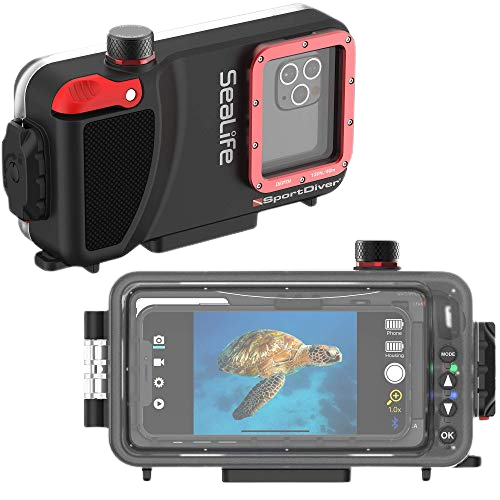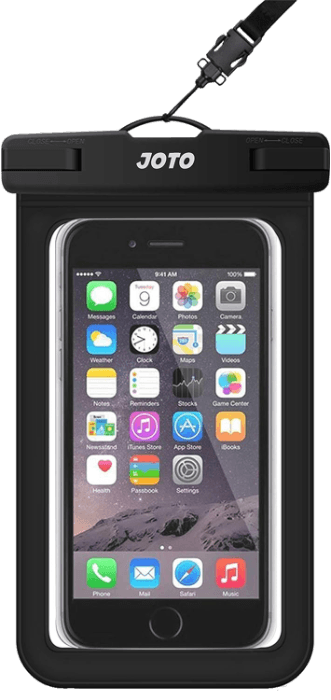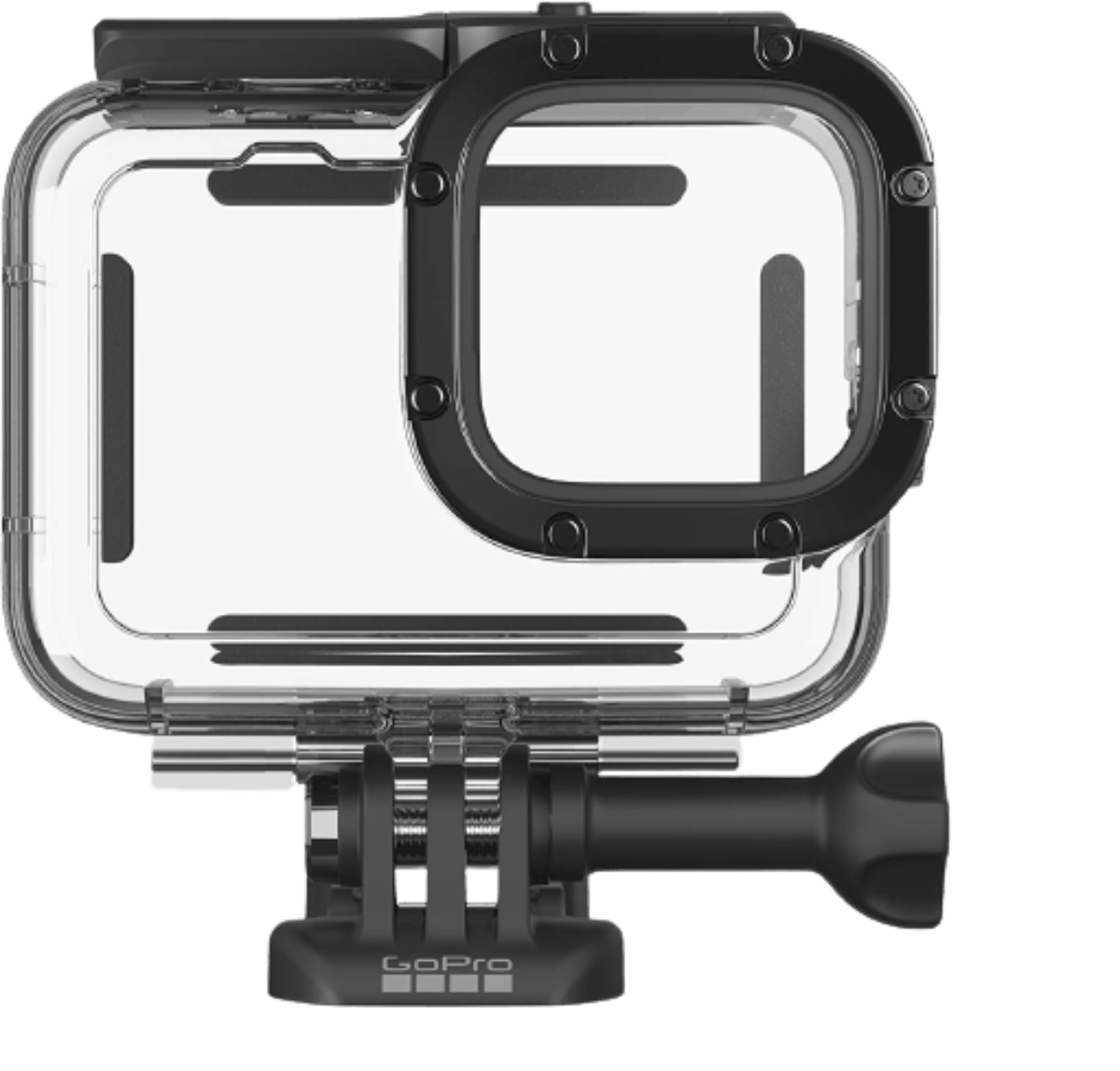You might think that an underwater camera housing is a great big plastic thing with an expensive camera inside. Think Life on Earth or Jaques Cousteau (depending on your age). But the truth is modern action cameras (and some smartphones) have blurred the lines in this field.
If you want to take your fancy DSLR underwater (or even directly above it), you might want to invest in big waterproof housing. But they are bulky and expensive. And for most of us, most of the time, there could be a good alternative.
Most action cameras have impressive waterproofing, even without a specialist housing. And you might find modest waterproofing on your phone as well.
We’ve gathered a range of solutions, from waterproof bags for splash protection to full-on diving housings. Whatever you need, you should find the answer or inspiration here.



What Is the Best Underwater Camera Housing?
It is an unnerving experience, dunking your camera underwater. So it’s important to make the right choice when choosing the best underwater camera housing. Before we look at the housings in more detail, here is a roundup of our top picks.
Choosing the Best Underwater Camera Housing
You’ll need to think about what use you want out of your camera. Is it hardcore diving or keeping it safe in your kayak or on the waterslide? Once you know what you want to use it for, pick the underwater camera housing that’s right for you.
Here are our choices in more detail.
1. Diverbox for iPhone Waterproof Case

| Brand |
Brand
Diverbox
|
| Designed For |
Designed For
iPhone
|
| Depth Rating |
Depth Rating
6.5 ft / 2 m
|
| Key Features |
Key Features
Maintains touchscreen functions and protects from shocks
|
| Best For |
Best For
Anyone looking for an everyday case that adds levels of protection to their iPhone
|
The Diverbox Waterproof Case for iPhone is unobtrusive enough to be used daily on your phone. And it is robust enough to protect it from drops, spills, and splashes. In many ways, the shock and scratch protection is most valuable. And that is because the Diverbox is rated IP68 for dust and water. This is the same rating as the iPhone itself for all models since the iPhone 8.
You won’t want to take it scuba diving or snorkeling. But you’ll feel happy with it by, or even in, the pool. And crucially, notorious camera-unfriendly locations like the beach will be more accessible to your photography. Sand and grit will have no luck getting into your phone.
A key consideration with any underwater camera housing is how much it affects the control of your camera. Especially with a smartphone, as the controls are increasingly touch-related rather than physical buttons. The Diverbox has this covered with a screen protector that allows full use of the screen. Physical buttons are also replicated on the housing. And the lenses and flash are unobstructed.
For a very reasonable price, the Diverbox Waterproof Case for iPhone gives you extra peace of mind for your phone. It allows you to venture into unfavorable places, knowing that your phone is safe. And it’s hugely beneficial to anyone who uses their iPhones daily in dusty, dirty, wet, or hard-knock environments.
2. Nisso Waterproof Underwater Snorkeling Phone Case for iPhone

| Brand |
Brand
Nisso
|
| Designed For |
Designed For
A wide range of smartphones
|
| Depth Rating |
Depth Rating
98 ft / 30 m
|
| Key Features |
Key Features
Sturdy case with handgrip and multi-handset compatibility
|
| Best For |
Best For
Anyone looking for a versatile underwater housing
|
The Nisso Waterproof Underwater Phone Case takes a slightly different approach to model compatibility. It is designed to work with a number of different handsets—both Android and iOS devices. You won’t have to change it when you change your phone. Or you can share it with family or friends.
On the other hand, you do sacrifice the convenience of the touchscreen. And it’s not a case you’ll keep on for everyday use.
First, you need to install your phone, which might involve adding foam pads to ensure the shutter button lines up with the relevant button on your phone. Next, you’ll have to make sure that your phone isn’t set to go to sleep mode unless you have face ID. Finally, you must select the camera mode you want before closing the case. You can’t do that once it’s locked.
Given that closing the case is (reassuringly) involved, you’ll want to make sure you remember all those steps. The case has six locking tabs, so it takes a while to close (and open). Very sensibly, Nisso suggests that you commit nothing more precious than a piece of paper to the case on first use. This will reassure you or demonstrate a faulty installation or product. Given that top-end smartphones cost upwards of a thousand dollars, this seems very sensible.
In use, the Nisso has a nice handgrip on the right-hand side. And the camera lens window is generously sized to be usable with a wide range of phones. There is a thread to take a selfie-stick. Or perhaps more sensibly, a floating handle. So if the worst happens, your precious phone won’t just sink to the bottom of the ocean. The Nisso comes with a lanyard to prevent the same thing.
The Nisso Waterproof Underwater Phone Case opens up hobbies like snorkeling to your iPhone photography. It’s not as convenient as the Diverbox, but it is designed for a slightly different purpose. It’s a great addition to your smartphone accessory kit.
3. SeaLife Underwater Smartphone Scuba Case

| Brand |
Brand
SeaLife
|
| Designed For |
Designed For
A wide range of smartphones
|
| Depth Rating |
Depth Rating
130 ft / 40 m
|
| Key Features |
Key Features
Dedicated app allows for control underwater, pressure and humidity alarms
|
| Best For |
Best For
Serious underwater phone photography
|
The SeaLife Underwater Smartphone Scuba Case is designed for more than a simple dip in the briny blue. Its rated depth of 130 feet/40 meters is considered the limit of non-technical scuba diving. So it’s a serious piece of kit.
So it is no surprise that it has an O ring seal, cam locking mechanism, and a pump to remove the air. Otherwise, its buoyancy would be a problem. Another sign of its serious application is the built-in warnings for moisture and vacuum pressure loss. You get an LED, audio, and on-screen alert if either fault is detected.
With a bulkier, sturdier housing comes increased problems with activating phone controls. SeaLife’s solution is an effective one. Install their app on your iOS or Android phone, and then the housing uses the phone’s physical buttons to control your camera. This means that rather than just shooting, you can adjust exposure variables and even switch between still and video.
For all these advanced specs, there is a price to pay. The SeaLife isn’t cheap. But on the other hand, if you are a scuba diver, you know that your hobby (or profession) is not a budget one. And this housing means you don’t need to invest in a separate camera and housing. With the quality of modern smartphones, this probably means that apart from professional underwater photographers, you won’t need more than this.
Other features like the detachable filter for optimizing the lighting underwater make the SeaLife Underwater Smartphone Scuba Case a strong contender in the field of the best underwater camera housing.
4. JOTO Waterproof Pouch Cellphone Dry Bag Case for iPhone 11

| Brand |
Brand
JOTO
|
| Designed For |
Designed For
Smartphones
|
| Depth Rating |
Depth Rating
100 ft / 30 m
|
| Key Features |
Key Features
Pouch for phone or passport or other valuables
|
| Best For |
Best For
Anyone looking for cheap and effective waterproof protection
|
The JOTO Waterproof Pouch is an unnervingly cheap way of protecting your precious smartphone. In fact, it works just as well for a wallet, passport, or similar. For phone use, it allows the touchscreen to remain functional and even face ID. (Although some users report that this is not always reliable.)
Due to its design, it will take any smartphone that physically fits inside. It also allows access to all the buttons you need and touchscreen functions. The depth rating is impressive as well. The touchscreen might not be fully responsive underwater, depending on depth (and phone). But this is a really easy product to use.
JOTO recommends that you test the pouch with paper first. This is probably as much to do with your confidence as protecting the phone. But it’s sound advice. Once you’re happy, though, your phone is safe, dry, and usable for less than ten dollars. It’s a real bargain.
Take your phone rafting, to the beach, or even snorkeling with the JOTO Waterproof Pouch. I’m sure you’ll truly appreciate the protection and peace of mind it brings.
5. DiCAPac WP-S10 Pro DSLR Waterproof Case

| Brand |
Brand
DiCAPap
|
| Designed For |
Designed For
DSLRs
|
| Depth Rating |
Depth Rating
16.3 ft / 5 m
|
| Key Features |
Key Features
Polycarbonate lens and finger sleeves
|
| Best For |
Best For
People looking for a good-value DSLR underwater housing
|
The DiCAPac WP-S10 Pro DSLR Waterproof Case is a waterproof pouch on steroids. Rather than a bag with a waterproof seal, it adds a lens tube, polycarbonate lens, and finger sleeves to allow you to operate the camera.
There’s one sleeve to operate the shutter and a finger and thumb pair to zoom or focus the lens. The lens tube itself allows a fair degree of extension from your lens. It’s a pretty decent solution, given that this is way short of the cost of a “proper” rigid underwater camera housing.
The waterproof rating of 16 feet 4 inches (5 meters) is as far as is feasible for a bag filled with air. In fact, wrestling with the housing’s inherent buoyancy will be one thing that can affect your underwater shooting. On the plus side, it’s unlikely you’ll watch in despair as your DSLR sinks to the deep should you drop it.
The waterproofing comes from a roll-top bag, like a dry sack. It’s effective, but the manufacturers recommend the standard paper test before use. As DSLR accessories go, this isn’t that expensive. And it does open up the field (or ocean) to your top-grade equipment.
We think the DiCAPac WP-S10 Pro DSLR Waterproof Case is a good value and useful approach to underwater camera housing.
6. GoPro Protective Housing

| Brand |
Brand
GoPro
|
| Designed For |
Designed For
GoPro action cameras
|
| Depth Rating |
Depth Rating
196 ft / 60m
|
| Key Features |
Key Features
Adds extra depth and shock protection for GoPro HERO cameras
|
| Best For |
Best For
GoPro users wanting to go deeper
|
The GoPro Protective Housing was likely the first underwater camera housing that any of us owned. In the early days of the HERO range of cameras, it was the only way of making them waterproof. More recent GoPros have a waterproof case, usually down to 33 feet (10 m). The waterproof housing is a way of extending that range.
The look of these cameras in their housings actually can make you nervous submerging your modern GoPro without a case. It just feels wrong because the camera itself doesn’t look waterproof.
Nonetheless, this housing takes your camera deeper than most scuba divers can go. And it offers protection against knocks and bumps. The locking mechanism is strong, and the housing has buttons to operate all the main controls on the camera.
There’s no problem getting clear photos as the polycarbonate shell is crisp and clear and resists scratching. If you want to take your GoPro to greater depths or in white water, it’s a sound choice. Or if you want to protect it from sand and dust and knocks. For all these reasons, the GoPro Protective Housing is a great choice.
7. Ikelite 6870.70 Underwater Camera Housing for Canon 70D

| Brand |
Brand
Ikelite
|
| Designed For |
Designed For
Canon EOS 70D
|
| Depth Rating |
Depth Rating
200 ft / 60 m
|
| Key Features |
Key Features
Camera-specific controls, vacuum pump
|
| Best For |
Best For
Anyone needing pro-level underwater protection and functionality
|
The Ikelite 6870.70 Underwater Camera Housing is the Canon EOS 70D version of Ikelite’s extensive range of housings. These are very serious accessories. They are fully featured and rated to a depth only technical divers can exceed. Despite being encased in a vacuum-sealed box, you have full control over your device.
It is even possible to zoom the lens using an optional zoom gear. This turns the zoom via an external control while underwater. Note that the rather steep price for this underwater camera housing is for the camera housing only. Separate units must be purchased for any lens you wish to use.
The Ikelite housing is vacuum sealed. Once you’re ready to go, you remove the air before diving. This ensures water can’t get in. More importantly, it means that the hosing is not buoyant, which would make using it at depth very difficult.
This is a full-fledged pro-level housing for pro-level cameras (although Ikelite also makes housings for more budget-minded cameras). The separate housing for your lenses means you can change lenses (out of the water!) without having to disassemble the camera housing. There’s even an external control for the lens release button to make this possible.
If you’re looking for a top-class underwater camera housing for your DSLR, the Ikelite 6870.70 Underwater Camera Housing is a high-quality choice.
Buyer’s Guide—The Best Underwater Camera Housing
I confess I get nervous even writing about taking my camera underwater. Most of us can’t just drop two or three thousand bucks on a new camera because the old one went for a swim. So it’s important to know that your choice is a sound one. There are some basic things to consider when looking for an underwater camera housing.
What Are IP Ratings, and Are They Important?
An IP rating means that a piece of equipment meets a certain standard set by the International Electrotechnical Commission. It stands for “ingress protection,” and it measures how well an item resists penetration by particles and liquids. If a product is listed as IP67, this means that it has the highest level (6) of dust protection and level 7 against water. This is immersion up to 3 feet 3 inches (1 m) for 30 minutes. There are nine levels of liquid protection.
The designation is important because it gives a trustworthy measure of how waterproof something is. The tests are internationally recognized and trustworthy (as long as the manufacturer is reputable).
Don’t Forget to Check Compatability
Some of these underwater camera housings are model-specific. Others are for a range of devices. Either way, double-check that your device fits. Otherwise, at best, it won’t work. At worst, it will fail underwater.
Where Possible, Test Before You Use It
Many manufacturers recommend putting nothing more valuable than a piece of toilet paper in the housing to test for leaks. It’s a good suggestion. A bathtub can be a good test bed, and the peace of mind will be priceless.
Conclusion: The Best Underwater Camera Housing
There is something serene and otherworldly about underwater photography. So any device that opens up this world is worth considering.
At the same time, you might just want to protect your equipment from splashing and dirt. The beach is about the most camera-unfriendly environment I can think of. Some of these housings are as valuable at the beach as they are underwater.
Whatever the purpose, these underwater camera housings will undoubtedly bring new depth to your photography.



